Home  Types of source Types of source  18th-century 18th-century  Women's distinctive vocabulary Women's distinctive vocabulary
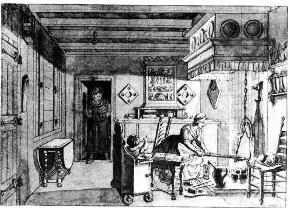 |
| Eighteenth-century Dutch kitchen interior. Source: Jane Austen's World. Click on the image to see an enlarged
version.
|
'The Distaff or the Kitchin': vocabulary relating to domestic and household
matters
Once women began to write and publish in significant numbers at the end of the seventheenth
and beginning of the eighteenth century, it was repeatedly commented - by both male and
female writers - that such activity was in competition with women's proper sphere, namely
the domestic household: sewing, cooking, and household management in general. Initiating a
correspondence with the philosopher John Norris in 1693, Mary Astell asked him to take
notice of her literary endeavours notwithstanding her departure from more appropriate female
employment:
Sir though some morose Gentlemen wou'd remit me to the Distaff or the Kitchin,
or at least to the Glass and the Needle, the proper Employment as they fancy of a woman's
Life; yet expecting better things from the more Equitable and ingenious Mr Norris, who Is
not so narrow-soul'd as to confine Learning to his own sex, or envy it in ours, I presume to
beg his Attention a little to the Impertinencies of a Woman's Pen... (Norris 1695: 1-2; for comment and context see
Perry 1986: 73ff.)
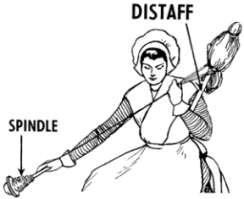 |
| Source: Wikipedia. Click on the image to see an enlarged version.
|
In 1710, the Tatler poured scorn on Astell's 'Scheme of a College for Young
Damsels', using much the same imagery to make the point that women should stick to their
own territory rather than usurping male provinces:
instead of Scissors, Needles, and Samplers; Pens, Compasses, Quadrants, Books,
Manuscripts, Greek, Latin and Hebrew are to take up [the women students'] whole Time. (Steele 1710: vol. 2, p. 199;
see Perry 1986: 229)
The perceived opposition between proper female domestic employment and intellectual
activity, particularly writing (or, in Astell's words, 'the Impertinencies of a Woman's
Pen'), continued strong throughout the eighteenth century (for examples of some typical
attitudes see Jones 1990:
chapter 4, 'Writing', pp. 140-91). Years later, Jane Austen's brother James felt he had to
justify his sister's labours by defending her against any imagined implication that she had
neglected the housework. In verses composed shortly after her death in 1817, he wrote:
They [her family] saw her ready still to share
The labours of domestic care
As if their prejudice to shame;
Who, jealous of fair female fame
Maintain, that literary taste
In women's mind is much displaced;
Inflames their vanity and pride,
And draws from useful works aside.
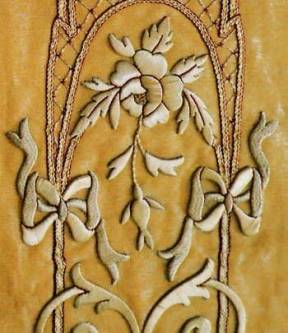 |
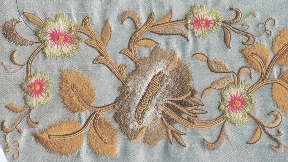 |
| Two examples of satin stitch. Top: goldwork: satin stitching in gold thread on cloth of gold. Courtesy of Mary Corbet's Needle 'n Thread. Bottom: satin stitch and 'skinny' cording. Courtesy of Gabriel Amaya at House of Embroidery. Click on each image to see an enlarged version.
|
Readers are assured that Austen did not stint on her useful works, the domestic labours
proper to women, and it is these James sees as manifesting 'Her real & genuine worth',
'Her Sisterly, her Filial love' (for full text of poem see Selwyn 2003: 86-8; it is also
reproduced online here from Southam 2002). (Austen afficionados will
remember that Leslie Stephen particularly noted the writer's domestic accomplishments in
his DNB entry of 1885: 'Jane learned French, a little Italian, could sing a few
simple old songs in a sweet voice, and was remarkably dexterous with her needle, and
"especially great in satin-stitch"'; Stephen takes his
information from J. E. Austen-Leigh's Memoir of Jane Austen and Other Family
Recollections, published in 1871, pp. 71, 77.)
For historians, whether literary or linguistic, this is a contentious and difficult matter.
Should we celebrate the importance to women of domestic matters, thereby running the risk of
keeping them shut up in the kitchen, or should we be suspicious of the urge to demonstrate
links between women and domesticity, thereby running the risk of ignoring one of the few
areas of activity in which they had the chance to excel?[1]
Whatever the right answer to this question, the close correlation claimed, and - as Astell's
letter shows - often resisted, between women and domesticity is in some instances strikingly
confirmed by the OED's citation sources for such vocabulary. If we look at the
quotations for one of the few female authors cited in large numbers in OED1, Jane
Austen (around 700 in total[2]),
we find a remarkable prevalence of words to do with domestic or household matters, e.g.
- beaver ('a particular kind of glove')
- butler's pantry ('a pantry where the plate, glass, etc., are kept')
- cousinly
- consequences (the game)
- spot ('a spotted textile material'), etc.
Burchfield's twentieth-century Supplement added nearly 350 more quotations from Austen, in
which the same characteristic dominates even more strongly, e.g.
- baby-linen
- baker's bread
- bath-bun,
- black butter (i.e. 'apple-butter')
- bobbinet ('A kind of machine-made cotton net, originally imitating the lace
made with bobbins on a pillow')
- brace ('One of a pair of straps of leather or webbing used to support the
trousers; a suspender')
- china crape
- china tea
- coffee urn
- corner shelf, etc.
 |
| Title page of Hannah Glasse's The Art of Cookery (1774)
taken from Google Books. Click on the
image to see an enlarged version.
|
Some other female writers, for example the seventeenth-century writer Hannah Woolley (c. 70
quotations) and the eighteenth-century writers Hannah Glasse (c. 400) and Elizabeth Raffald
(c. 270) are cited almost entirely for domestic cooking terms taken from their books on
cookery and housewifery. The same is occasionally true for male writers too (e.g. J. Knott,
quoted around 70 times for culinary terms from his Cook's & Confectioner's
Dictionary of 1723).[3]
In general, the explanation for the female provenance of the
quotation sources for such vocabulary must be that domestic and household matters were often
a matter of discussion or responsibility for female writers rather than for male. But it may
also be the case, given prevailing assumptions about women's roles and women's
characteristic subjects of interest, that the OED lexicographers were more likely
to pick up on such vocabulary in female- than in male-authored sources. To clarify this
question we need to carry out more research into both source texts and the OED
itself.
Several further points of interest arise:
(i) Many of these domestic terms in Austen's writing - including all those quoted above -
are also first quotations in OED. This is a notable feature. In
particular, of Burchfield's 350-odd additions of Austen quotations to OED in the
twentieth-century Supplement, about half are first quotations. Was Austen really the first
person to use these terms in print? or does OED cite them from her work simply
because this was relatively thoroughly combed by the lexicographers and readers, i.e.
OED was more likely to find such vocabulary in Austen than in other less well known
sources? (and also, as suggested above, that readers and lexicographers would have a prior
expectation that texts written by women were a good source for such terms?) Again, we need
to read and research further to try to establish an answer to this question.
(ii) Notwithstanding OED's comparatively thorough treatment of Austen, the readers
or lexicographers on occasion still overlooked such terms in her writing. Sometimes they
went altogether unrecorded, e.g.
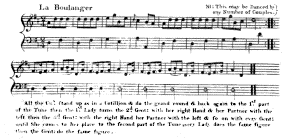 |
| Music and (somewhat illegible) instructions for the Boulanger
('baker') dance. Source: Jane Austen Information
Page. Click on the image to see an enlarged version.
|
- Boulanger (a dance): in Pride & Prejudice, 1.iii.13, Mr Bingley
danced 'the two sixth with Lizzy, and the Boulanger'; the term crops up again in the
Letters (5 September 1796; Le Faye 1995: 8), 'We dined at Goodnestone,
and in the evening danced two country dances and the Boulangeries')
- family party: as in Pride & Prejudice, III.xviii.384, 'The comfort
and elegance of their family party at Pemberley'
- netting silk: as in 'There were no narrow Braces for Children, & scarcely
any netting silk' (letter of 27-28 October 1798 from Austen to her sister Cassandra, Le Faye 1995: 75).
OED3 draft entry June 2008 lists several sewing-related compounds for
netting (n.3, s.v. C1), e.g. netting-cord, -cotton,
-needle, etc., but misses this one
- out of place ('without a place or situation', said of a domestic servant): as
in 'I believe I could help them to a housemaid, for my Betty has a sister out of place',
(Sense & Sensibility, III.i.260). Cf. OED3 draft entry June 2009 s.v.
place, 14a: 'A job, office, or situation'; the Dictionary does not recognize the
phrase 'out of place'. The phrase is used by both Good Mrs Brown and Rob in Dombey and
Son, XVII.lii (p. 775 in Oxford Classics edition), 1848: '"You're not out of
place, Robby?" said Mrs. Brown in a wheedling tone. "Why, I'm not exactly out of
place, nor in," faltered Rob. "I - I'm still in pay, Misses Brown."'
- working candle ('candle for working [e.g. sewing] by'), as in 'I hope it won't
hurt your eyes - will you ring the bell for some working candles?' (Sense &
Sensibility, II .i.144)
Alternatively, the terms were sometimes recorded in OED, but Austen's prior use was
missed: e.g.
- lottery (the card game), mentioned in Pride & Prejudice, I.xvi.84
(first published 1813) but dated from 1830 onwards in OED.
Or occasionally what was missed was an example of usage which supplied valuable additional
evidence for a term under-represented in OED's quotation record:
- satin-stitch: 'I beleive I must work a muslin cover
in sattin stitch, to keep it from the dirt' (letter of 17-18 January 1809 from Austen to her
sister Cassandra, Le Faye
1995: 165). OED records only two examples of this term, from Hannah Wooley's
work on household management, Supplement to The Queen-like Closet, dated
1684, and Fanny Trollope's novel The Widow Married of 1840: Austen's instance
usefully bridges the 156-year gap between these two quotations.
(iii) Similarly, domestic and household vocabulary in other eighteenth-century female
writers was also occasionally missed by OED, even in writers whose work they read
and quoted from relatively intensively, e.g.
- Wortley Montagu's use of the term brass: 'he proffers to...see to get Pewter
and Brass as much as you will have occassion for' (Halsband 1965: vol. 1, p. 193). OED2
recorded the definition 'Pewter utensils collectively; pewterware' for pewter but
has no analogous definition for brass
- The same writer furnishes an antedating for the term braziery, to mean 'brass
household equipment of various sorts', in a letter of 1713: 'you have plates hir'd for 5s.,
and other Pewter at the rate of one d. per pound. But we are like to have a good deal of
trouble to get Brazerie' (Halsband 1965: vol. 1, p. 195);
OED1/2 does not recognize the specific household application and defines simply
'Brazier's work', with a first quotation of 1795
- Seward's use in a letter of 1790 of winter-room, a combinatorial form which
OED records only from 1911: 'It is the pleasantest winter-room in the house, where
many are pleasant; - but the sun looks on this at noon, and gilds it on through the winter
day' (1790; Constable
1811: vol. 3, p. 37).
(iv) Finally, such terms are sometimes recorded but with insufficient information to be able
to understand the implication of their usage. An example is:
- thread-satin, listed in OED1/2 without comment as a combinatorial form
of thread, with a quotation from the London Gazette of 1713 ('A Thread-
Sattin Night-Gown, striped red and white'). Wortley Montagu writes in a letter of 1721, 'I
have taken my thread satin Beauty into the house with me. She is allow'd by Bononcini to
have the finest Voice he ever heard in England' (Halsband 1965: vol. 2, p. 13). As Halsband's
notes tell us, the reference is to Anastasia Robinson (d. 1755), 'prima donna', closely
associated with Bononcini. Wortley Montagu's use is clearly figurative but what does
thread-satin mean? Is she referring to the (poor-quality?) dress material Robinson
wore, or intending some reflection on the singer's voice or her character?
Footnotes
[1] See further Macheski 1986.
[2] Our graph of Top female sources in Initial results represents Austen's quotations as over
1,000 in all. This is because the data for the graph is taken from electronic searching of
OED2, which combines OED1 with Burchfield's Supplement. EOED has since
searched the Supplement manually and discovered that Burchfield was responsible for adding
around 350 of the OED2 quotations, a matter to be discussed further on our Austen
pages here [under construction**].
[3] The quotations from Nott seem all to have
been added to OED by Burchfield in the twentieth-century Supplement, perhaps at the
prompting of Marghanita Laski.
|
|
Last Updated ( Wednesday, 17 March 2010 )
|
|
|
|